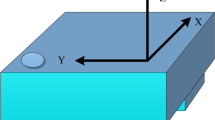Abstract
The optimization of swimming training scheme is of great significance to improve the training efficiency and competitive performance of swimmers. However, the traditional swimming training programs often lack of personalized and scientific, can not meet the characteristics and needs of different athletes. The aim of this paper is to realize the automatic recognition of motion trajectory through optical processing technology, so as to improve the swimming training scheme. The optical processing technology of remote sensing image is used to collect video images during swimming training, and the optical processing algorithm is used to extract the trajectory information of swimmers in the images. Then image processing and pattern recognition technology are used to identify and analyze the trajectory, so as to obtain accurate trajectory data. Finally, based on the analysis results, the swimming training scheme is optimized and personalized training suggestions are provided. Through the experiment and result analysis, the effectiveness of optical processing in the optimization of swimming training scheme is verified. Through the automatic identification and analysis of the movement trajectory, the swimmer’s skill and ability level can be more accurately understood, thus providing a scientific basis for the formulation and adjustment of training programs. The optical processing can also monitor and record the swimmers' trajectory changes in real time, providing real-time feedback and guidance for coaches to further improve the training effect.



Similar content being viewed by others
Data availability
The data will be available upon request.
References
Alomari, M.A., Alzoubi, K.H., Khabour, O.F.: Swimming exercise improves short-and long-term memories: Time-course changes. Physiol. Rep. 9(11), e14851 (2021)
Awad, F.H., Hamad, M.M.: Improved k-means clustering algorithm for big data based on distributed smartphoneneural engine processor. Electronics 11(6), 883 (2022)
de Zeeuw, M., Smolianov, P., Dion, S., Schoen, C.: Comparing the practices of Dutch swimming against a global model for integrated development of mass and high performance sport. Manag. Sport Leisure 22(2), 91–112 (2017)
Díaz, R.J.T.: Swimming in the Ecuadorian school and extracurricular sport: A proposal of curricular improvement. Revista PODIUM 16(1), 40–51 (2021)
Duan, Y., Li, P., Meng, D., Bu, T., Liu, X., Popovic, S., Matic, R.M.: The effects of demographic trends on the high-quality development of the Chinese sports industry. Sustainability 14(2), 1039 (2022)
Hibberd, E.E., Laudner, K.G., Kucera, K.L., Berkoff, D.J., Yu, B., Myers, J.B.: Effect of swim training on the physical characteristics of competitive adolescent swimmers. Am. J. Sports Med. 44(11), 2813–2819 (2016)
Hong, J., Chun, C., Kim, S.J., Park, F.C.: Gaussian process trajectory learning and synthesis of individualized gait motions. IEEE Trans. Neural Syst. Rehabilit. Eng. 27(6), 1236–1245 (2019)
Hou, P., Zhang, Y.: Dynamic image sampling and swimming motion image recognition in immersive virtual reality. Microprocessors and Microsyst. 82, 103760 (2021)
Larsson, J., Airey, J., Lundqvist, E.: Swimming against the tide: five assumptions about physics teacher education sustained by the culture of physics departments. J. Sci. Teach. Educ. 32(8), 934–951 (2021)
Lee, J., Kim, J.: Development of survival swimming curriculum for prevention of drowning: Delphi method. J. Coastal Res. 91(SI):196-200 (2019).
Li, P., Liu, W.: Research on the participation of Chinese sports cultural elite in ice and snow sports. Front. Public Health 9, 820765 (2022)
Li, J.H., Park, D., Ki, G.: Autonomous swimming technology for an AUV operating in the underwater jacket structure environment. Int. J. Naval Archit. Ocean Eng. 11(2), 679–687 (2019)
McGibbon, K.E., Pyne, D.B., Shephard, M.E., Thompson, K.G.: Pacing in swimming: a systematic review. Sports Med. 48, 1621–1633 (2018)
Olstad, B.H., Berg, P.R., Kjendlie, P.L.: Outsourcing swimming education—experiences and challenges. Int. J. Environ. Res. Public Health 18(1), 6 (2021)
Paniccia, D., Graziani, G., Lugni, C., Piva, R.: The relevance of recoil and free swimming in aquatic locomotion. J. Fluids Struct. 103, 103290 (2021)
Pollard, B., Fedonyuk, V., Tallapragada, P.: Swimming on limit cycles with nonholonomic constraints. Nonlinear Dyn. 97, 2453–2468 (2019)
Rein, R., Memmert, D.: Big data and tactical analysis in elite soccer: future challenges and opportunities for sports science. SpringerPlus 5(1), 1–13 (2016)
Suda, S., Suda, T., Ohmura, T., Ichikawa, M.: Straight-to-curvilinear motion transition of a swimming droplet caused by the susceptibility to fluctuations. Phys. Rev. Lett. 127(8), 088005 (2021)
Zhong, J., Sun, H., Cao, W., He, Z.: Pedestrian motion trajectory prediction with stereo-based 3D deep pose estimation and trajectory learning. IEEE Access 8, 23480–23486 (2020)
Funding
The authors have not disclosed any funding.
Author information
Authors and Affiliations
Contributions
W.J. has contributed to the paper’s analysis, discussion, writing, and revision.
Corresponding author
Ethics declarations
Conflict of interest
The authors declare that they have no competing interests.
Ethical approval
Not applicable.
Additional information
Publisher's Note
Springer Nature remains neutral with regard to jurisdictional claims in published maps and institutional affiliations.
Rights and permissions
Springer Nature or its licensor (e.g. a society or other partner) holds exclusive rights to this article under a publishing agreement with the author(s) or other rightsholder(s); author self-archiving of the accepted manuscript version of this article is solely governed by the terms of such publishing agreement and applicable law.
About this article
Cite this article
Jiang, W. Application of motion trajectory recognition based on remote sensing image optical processing in optimizing swimming training schemes. Opt Quant Electron 56, 264 (2024). https://doi.org/10.1007/s11082-023-05874-7
Received:
Accepted:
Published:
DOI: https://doi.org/10.1007/s11082-023-05874-7




